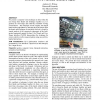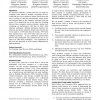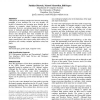CHI
2004
ACM
14 years 4 months ago
2004
ACM
Due to fierce industry competition and demand for novelty, games are a fertile research setting for studying interface design, input devices, graphics, social communication and de...
VRST
2005
ACM
14 years 5 months ago
2005
ACM
Much work has been done on the development of laser pointers as interaction devices. Typically a camera captures images of a display surface and extracts a laser pointer dot locat...
HAPTICS
2005
IEEE
14 years 5 months ago
2005
IEEE
Narrow key pitch of compact input devices confuses finger pressure at a key touch pad. To make keys more distinguishable and to improve user-friendliness of such input devices, w...
VRST
2006
ACM
14 years 5 months ago
2006
ACM
In this paper a 3D tracking system for Virtual Environments is presented which utilizes infrared (IR) laser technology. Invisible laser patterns are projected from the user(s) to ...
UIST
2006
ACM
14 years 5 months ago
2006
ACM
We present a computer vision technique to detect when the user brings their thumb and forefinger together (a pinch gesture) for close-range and relatively controlled viewing circu...
OZCHI
2006
ACM
14 years 5 months ago
2006
ACM
We present LookPoint, a system that uses eye input for switching input between multiple computing devices. LookPoint uses an eye tracker to detect which screen the user is looking...
CHINZ
2006
ACM
14 years 5 months ago
2006
ACM
Although the 2D desktop metaphor has been the dominating paradigm of user interfaces for over two decades, 3D models of interaction are becoming more feasible due to advances in c...
TABLETOP
2006
IEEE
14 years 5 months ago
2006
IEEE
In this paper we present the Transparent Input Device Layer framework to extend Java applications with support for multiple distributed input devices, a major requirement for tabl...
AUIC
2006
IEEE
14 years 5 months ago
2006
IEEE
In this paper, we present a framework to use an arbitrary number of mouse and keyboard input devices controlling Swing based Java applications. These devices can be distributed am...
VR
2008
IEEE
14 years 5 months ago
2008
IEEE
We present two studies to assess which physical factors of various input devices influence 3D object movement tasks. In particular, we evaluate the factors that seem to make the m...



